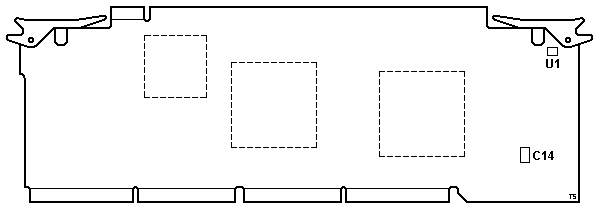|
rf90954a.exe Reference Disk Type 4 Processor Complex v1.34 (zipped image)
rd9095a.exe Diagnostic Disk Type 1 - 4 Processor Complex v2.33 (zipped image)
"N" / Upgrade 486DX2 66 MHz
"N" Complex Front
"N" Complex Back
Memory supported, cache
ECA0002 01291500 Errors
Possible -xNx Overclock?
-xNx Upgrades?
"N" / Upgrade 486DX2 66 MHz 61G2343, FCC ID ANOIBM486C33
"N" Complex Front
![Front [P]](/other/img/photo.gif)
![Front (alt) [P]](/other/img/photo.gif)

U85 LT1085CT
Adjustable Voltage Regulator with max. output current 3.0 A. The regulator is
set to 3.7 (3.75) V and powers the SynchroStream Controller.
Unlike the Pentium-based T4 complexes the "N" doesn't have a custom clock
generator (87X0079). TI CDC328 (U30)
and 74ACQ244 (U32) are used to
distribute the 40 MHz and 33.33 MHz clocks respectively.
Supports processors with CPUID 041xh or 043xh (Intel 486 stepping info
HERE). There is no explicit CPUID check in the
firmware. Instead this seems to be a hardware related limitation.
"N" Complex Back
![Back [P]](/other/img/photo.gif)
Nothing really interesting, mostly just 74xx glue logic and bypass caps.
No cache chips on the back side - "N" has only 5 chips (4 + 1 parity)
on the component side.

U1 LT1109-12 DC/DC Conv. (Flash Vpp)
C14 Tantalum Cap 10 uF / 20 V (Flash Vpp)
U1, CR3, L1 & C14
(plus some other passives) are part of a local 12 V voltage generator.
This additional "programming voltage" (Vpp) is required by the Flash memory
to perform erase/write operations. Its general topology closely replicates
the "Flash Memory VPP Generator" circuit from the
LT1109 datasheet (page 1).
A local 12 V generator is necessary because the processor complex is supplied
with 5 V only.
Memory
RAM:
PS/2 72-pin SIMMs, ECC or Parity, 70 ns Presence Detect
Min/Max on system board: 8/64 MB Parity, 8/256 MB ECC
ROM:
256 KB (2 x 128 KB) Flash ROM
Cache:
L1: 8 KB (486DX2)
L2: 128 KB write-back
ECA0002
If you get Intermittent 01291500 errors and intermittent hangs, or SYS000915
errors under OS/2 using an N complex, FRU 61G2343, then this ECA probably
applies.
Note: The upgrade Type 1 DX2-66 FRU 92F0145
is NOT affected.
To check if your complex is affected, note the manufacturing
P/N on a sticker just below the CPU. If the manufacturing number is 82G3513,
06H3368, or 61G4072 with no patch wire on the back [described below], it
is affected.
Note: I have a 61G4072 with a patch wire
on the front. It seems to work. But the U69 and U60 ICs do not match.
Complexes 06H7263, 06H7264, and 06H7265 with the wire patch are not affected.
Complexes with FRU 06H7266 are not affected. (Ed.
New level production?)
Wire Patch on Back
There are two ICs, U60 and U69. U60 is 74F04D, 14 pin and U69
is 74ABT374D, 20 pin. The patch wire runs from the top left of U69 across
to the right, then down to R1, then from the bottom of R1 to the left,
where it connects to the bottom right of U60. If your 61G2343 does not
match the U69 (74ABT374D) and U60 (74F04D), then this ECA does not apply.
_____________________________________________________________
| XXXXXXX <-------- MFG CARD PART NUMBER
|
| ________________
| |_.----. |<--- WIRE-ADDED FROM U69 TO R1
| | | | INDICATES NEW LEVEL BOARD.
| | U | .---. |
| | 6 | | U | .-. MODULE'S IDENTIFICATION:
| | 9 | | 6 | |_|R1 U60 - 74F04D, 14-PIN MODULE
| | | | 0 |___| U69 - 74ABT374D, 20-PIN MODUL
| | | '---'
| | |
| '----'
|
|
|
|
|_ _ _ _ _
|_____________| |____________| |___________| |_________| |
-xNx Overclock?
From Tatsuo Sunagawa:
The board accepts 40.00 MHz oscillator instead of 33.33 MHz
without any changes of BIOS. But with 45.00 MHz, it doesn't work.
I don't have same type oscillator, so I'm using square metal package
oscillator with socket.
(Ed. Does this mean
an AMD/Cyrix 486DX-80 might work? The 486DX-80 was for systems with a 40 MHz
clock... Watch the voltage! The DX-80 was a 3.45 V chip, FAIK...)
-xNx Upgrades?
From Tim Clarke:
Type-4 DX2-66 will take:
- Intel/IBM DX2-66 (5 V parts, x2 clocking)
- Intel DX2-66ODPR (5 V parts, x2 clocking)
- All others *fail* to reach 'logo' screen (presumed BIOS 'sensitivity')
> But is overclocking possible with this?
Yes, the 'sensitivity' I remarked upon was in relation to x3 clocking ratios
and above, *not* increasing the 'base clock' and staying with x2 clocking. My
initial reaction is that a 40 MHz x2 (i.e. 80 MHz) chip would work very well,
especially those with the 'bigger' 16 KB L1 on-chip cache.
Ed. Please report experiences. Also, do be
careful - the parts may be able to take the overclock. Make sure the side fan
works. Keep the complex clean.
Current N Upgrade Attempts
I tried a Socket 3 transplant onto an N (procedure performed by Jim
Shorney). At the same time, a 40 MHz oscillator was tried. The 40 MHz
oscillator wasn't cooperation. At present, the Socket 3 modified complex will
not respond on a 9590. Possibly too crude of a planar?
Complex refuses to run on a model 90, but came up on an
M class 95 planar. Still refused to complete booting with anything other
than a DX2-66. Interposer failed to enable booting with a POD. Possible
timing or cache related problems.
9595 Server 95 (AKA "Server 95 466") (Type 4 ref. disk)
1NG - 486DX2-66, 16/256 MB (ECC), 540 MB SCSI-2, 2.88 MB floppy
1NT - 486DX2-66, 16/256 MB (ECC), 1 GB SCSI-2, 2.88 MB floppy
1NV - 486DX2-66, 16/256 MB (ECC), 2 GB SCSI-2, 2.88 MB floppy
9595 Server 95 Array (called 95A) (9 drive bays - Type 4 ref. disk)
3NG - 486DX2-66, 16/256 MB (ECC), 3 x 540 MB SCSI-2, 2.88 MB floppy
3NT - 486DX2-66, 16/256 MB (ECC), 3 x 1 GB SCSI-2, 2.88 MB floppy
|